Lab Report: Examining Eye Color Genetics in Drosophila Melanogaster
VerifiedAdded on 2023/05/30
|8
|1764
|113
Report
AI Summary
This lab report examines the inheritance of eye color in Drosophila melanogaster (fruit flies). The introduction provides background on the use of fruit flies as a model organism in genetics, including key concepts like alleles, genotypes, phenotypes, and the distinction between autosomes and sex chromosomes. The experiment aims to investigate the inheritance patterns of eye color, hypothesizing whether the gene is located on an autosome or the X-chromosome. The results section presents observed and expected data for male and female flies with red and brown eye colors. The discussion includes a Chi-square test to determine the statistical significance of the data and whether it supports either the autosomal or X-linked inheritance hypotheses. The report concludes that the X-linked inheritance hypothesis is accepted, with a discussion of potential limitations and suggestions for future research, such as investigating the inheritance patterns in subsequent generations or with other traits.

Running head: LAB REPORT: DROSOPHILA MELANOGASTER EYE COLOR
1
Lab report: Drosophila melanogaster eye color
Name:
Institution:
1
Lab report: Drosophila melanogaster eye color
Name:
Institution:
Paraphrase This Document
Need a fresh take? Get an instant paraphrase of this document with our AI Paraphraser
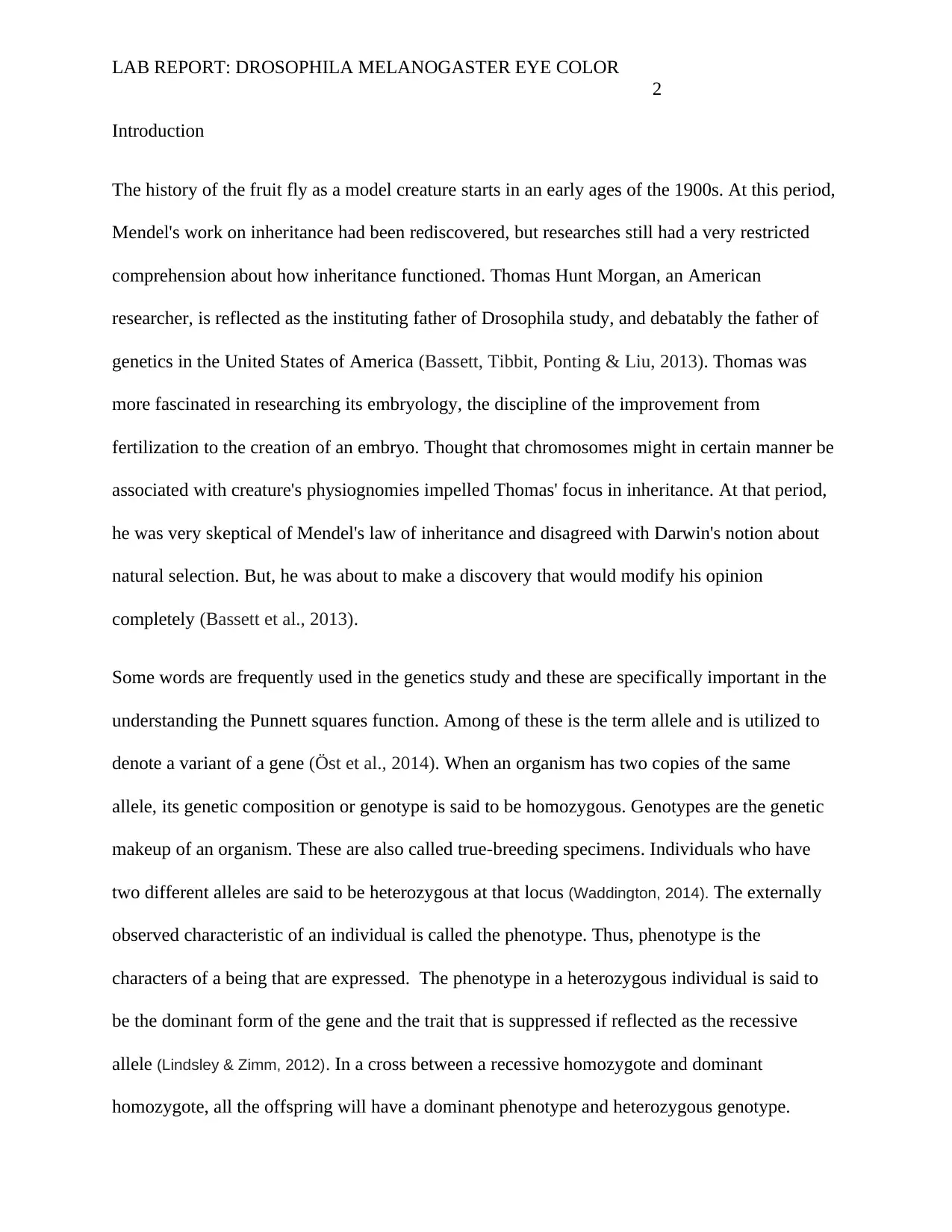
LAB REPORT: DROSOPHILA MELANOGASTER EYE COLOR
2
Introduction
The history of the fruit fly as a model creature starts in an early ages of the 1900s. At this period,
Mendel's work on inheritance had been rediscovered, but researches still had a very restricted
comprehension about how inheritance functioned. Thomas Hunt Morgan, an American
researcher, is reflected as the instituting father of Drosophila study, and debatably the father of
genetics in the United States of America (Bassett, Tibbit, Ponting & Liu, 2013). Thomas was
more fascinated in researching its embryology, the discipline of the improvement from
fertilization to the creation of an embryo. Thought that chromosomes might in certain manner be
associated with creature's physiognomies impelled Thomas' focus in inheritance. At that period,
he was very skeptical of Mendel's law of inheritance and disagreed with Darwin's notion about
natural selection. But, he was about to make a discovery that would modify his opinion
completely (Bassett et al., 2013).
Some words are frequently used in the genetics study and these are specifically important in the
understanding the Punnett squares function. Among of these is the term allele and is utilized to
denote a variant of a gene (Öst et al., 2014). When an organism has two copies of the same
allele, its genetic composition or genotype is said to be homozygous. Genotypes are the genetic
makeup of an organism. These are also called true-breeding specimens. Individuals who have
two different alleles are said to be heterozygous at that locus (Waddington, 2014). The externally
observed characteristic of an individual is called the phenotype. Thus, phenotype is the
characters of a being that are expressed. The phenotype in a heterozygous individual is said to
be the dominant form of the gene and the trait that is suppressed if reflected as the recessive
allele (Lindsley & Zimm, 2012). In a cross between a recessive homozygote and dominant
homozygote, all the offspring will have a dominant phenotype and heterozygous genotype.
2
Introduction
The history of the fruit fly as a model creature starts in an early ages of the 1900s. At this period,
Mendel's work on inheritance had been rediscovered, but researches still had a very restricted
comprehension about how inheritance functioned. Thomas Hunt Morgan, an American
researcher, is reflected as the instituting father of Drosophila study, and debatably the father of
genetics in the United States of America (Bassett, Tibbit, Ponting & Liu, 2013). Thomas was
more fascinated in researching its embryology, the discipline of the improvement from
fertilization to the creation of an embryo. Thought that chromosomes might in certain manner be
associated with creature's physiognomies impelled Thomas' focus in inheritance. At that period,
he was very skeptical of Mendel's law of inheritance and disagreed with Darwin's notion about
natural selection. But, he was about to make a discovery that would modify his opinion
completely (Bassett et al., 2013).
Some words are frequently used in the genetics study and these are specifically important in the
understanding the Punnett squares function. Among of these is the term allele and is utilized to
denote a variant of a gene (Öst et al., 2014). When an organism has two copies of the same
allele, its genetic composition or genotype is said to be homozygous. Genotypes are the genetic
makeup of an organism. These are also called true-breeding specimens. Individuals who have
two different alleles are said to be heterozygous at that locus (Waddington, 2014). The externally
observed characteristic of an individual is called the phenotype. Thus, phenotype is the
characters of a being that are expressed. The phenotype in a heterozygous individual is said to
be the dominant form of the gene and the trait that is suppressed if reflected as the recessive
allele (Lindsley & Zimm, 2012). In a cross between a recessive homozygote and dominant
homozygote, all the offspring will have a dominant phenotype and heterozygous genotype.
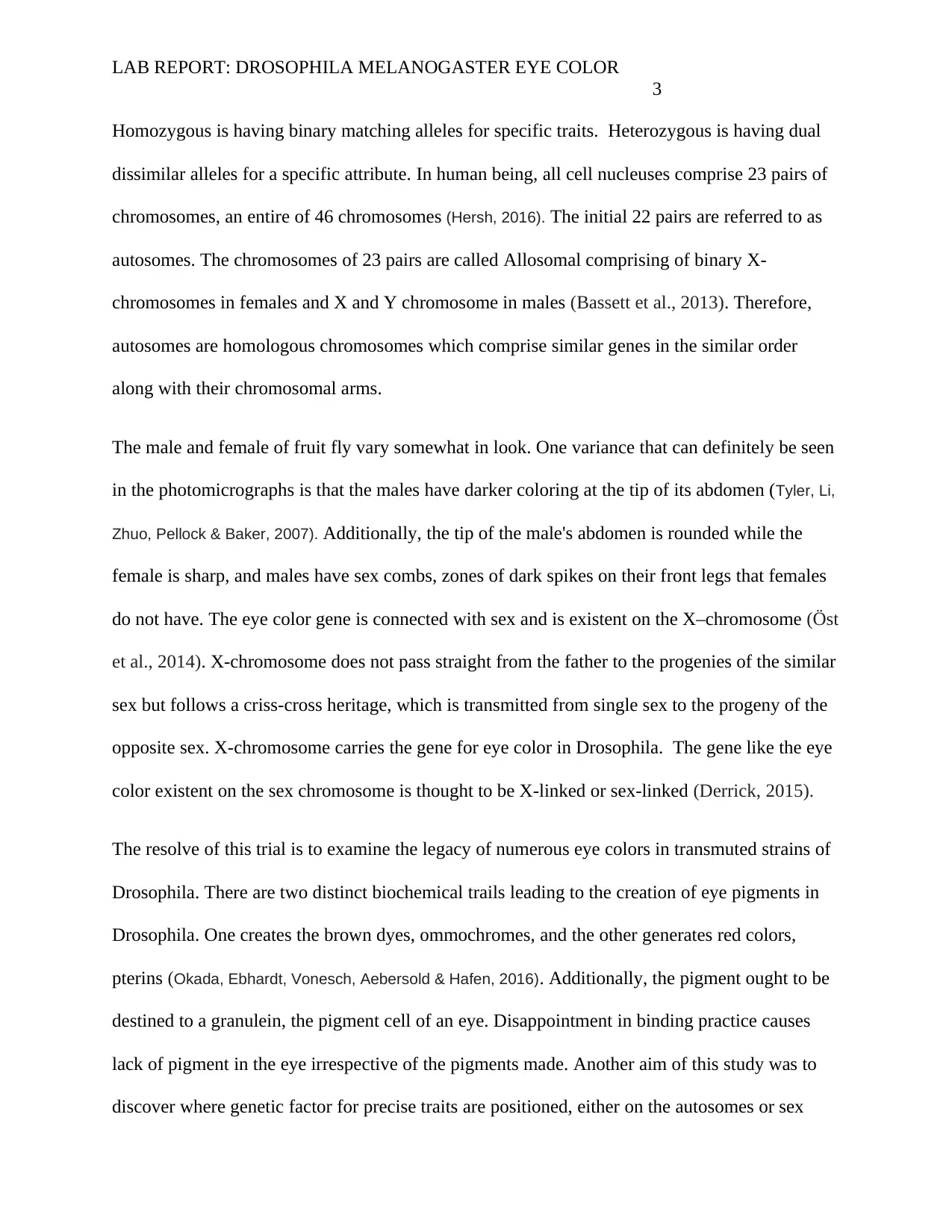
LAB REPORT: DROSOPHILA MELANOGASTER EYE COLOR
3
Homozygous is having binary matching alleles for specific traits. Heterozygous is having dual
dissimilar alleles for a specific attribute. In human being, all cell nucleuses comprise 23 pairs of
chromosomes, an entire of 46 chromosomes (Hersh, 2016). The initial 22 pairs are referred to as
autosomes. The chromosomes of 23 pairs are called Allosomal comprising of binary X-
chromosomes in females and X and Y chromosome in males (Bassett et al., 2013). Therefore,
autosomes are homologous chromosomes which comprise similar genes in the similar order
along with their chromosomal arms.
The male and female of fruit fly vary somewhat in look. One variance that can definitely be seen
in the photomicrographs is that the males have darker coloring at the tip of its abdomen (Tyler, Li,
Zhuo, Pellock & Baker, 2007). Additionally, the tip of the male's abdomen is rounded while the
female is sharp, and males have sex combs, zones of dark spikes on their front legs that females
do not have. The eye color gene is connected with sex and is existent on the X–chromosome (Öst
et al., 2014). X-chromosome does not pass straight from the father to the progenies of the similar
sex but follows a criss-cross heritage, which is transmitted from single sex to the progeny of the
opposite sex. X-chromosome carries the gene for eye color in Drosophila. The gene like the eye
color existent on the sex chromosome is thought to be X-linked or sex-linked (Derrick, 2015).
The resolve of this trial is to examine the legacy of numerous eye colors in transmuted strains of
Drosophila. There are two distinct biochemical trails leading to the creation of eye pigments in
Drosophila. One creates the brown dyes, ommochromes, and the other generates red colors,
pterins (Okada, Ebhardt, Vonesch, Aebersold & Hafen, 2016). Additionally, the pigment ought to be
destined to a granulein, the pigment cell of an eye. Disappointment in binding practice causes
lack of pigment in the eye irrespective of the pigments made. Another aim of this study was to
discover where genetic factor for precise traits are positioned, either on the autosomes or sex
3
Homozygous is having binary matching alleles for specific traits. Heterozygous is having dual
dissimilar alleles for a specific attribute. In human being, all cell nucleuses comprise 23 pairs of
chromosomes, an entire of 46 chromosomes (Hersh, 2016). The initial 22 pairs are referred to as
autosomes. The chromosomes of 23 pairs are called Allosomal comprising of binary X-
chromosomes in females and X and Y chromosome in males (Bassett et al., 2013). Therefore,
autosomes are homologous chromosomes which comprise similar genes in the similar order
along with their chromosomal arms.
The male and female of fruit fly vary somewhat in look. One variance that can definitely be seen
in the photomicrographs is that the males have darker coloring at the tip of its abdomen (Tyler, Li,
Zhuo, Pellock & Baker, 2007). Additionally, the tip of the male's abdomen is rounded while the
female is sharp, and males have sex combs, zones of dark spikes on their front legs that females
do not have. The eye color gene is connected with sex and is existent on the X–chromosome (Öst
et al., 2014). X-chromosome does not pass straight from the father to the progenies of the similar
sex but follows a criss-cross heritage, which is transmitted from single sex to the progeny of the
opposite sex. X-chromosome carries the gene for eye color in Drosophila. The gene like the eye
color existent on the sex chromosome is thought to be X-linked or sex-linked (Derrick, 2015).
The resolve of this trial is to examine the legacy of numerous eye colors in transmuted strains of
Drosophila. There are two distinct biochemical trails leading to the creation of eye pigments in
Drosophila. One creates the brown dyes, ommochromes, and the other generates red colors,
pterins (Okada, Ebhardt, Vonesch, Aebersold & Hafen, 2016). Additionally, the pigment ought to be
destined to a granulein, the pigment cell of an eye. Disappointment in binding practice causes
lack of pigment in the eye irrespective of the pigments made. Another aim of this study was to
discover where genetic factor for precise traits are positioned, either on the autosomes or sex
⊘ This is a preview!⊘
Do you want full access?
Subscribe today to unlock all pages.

Trusted by 1+ million students worldwide
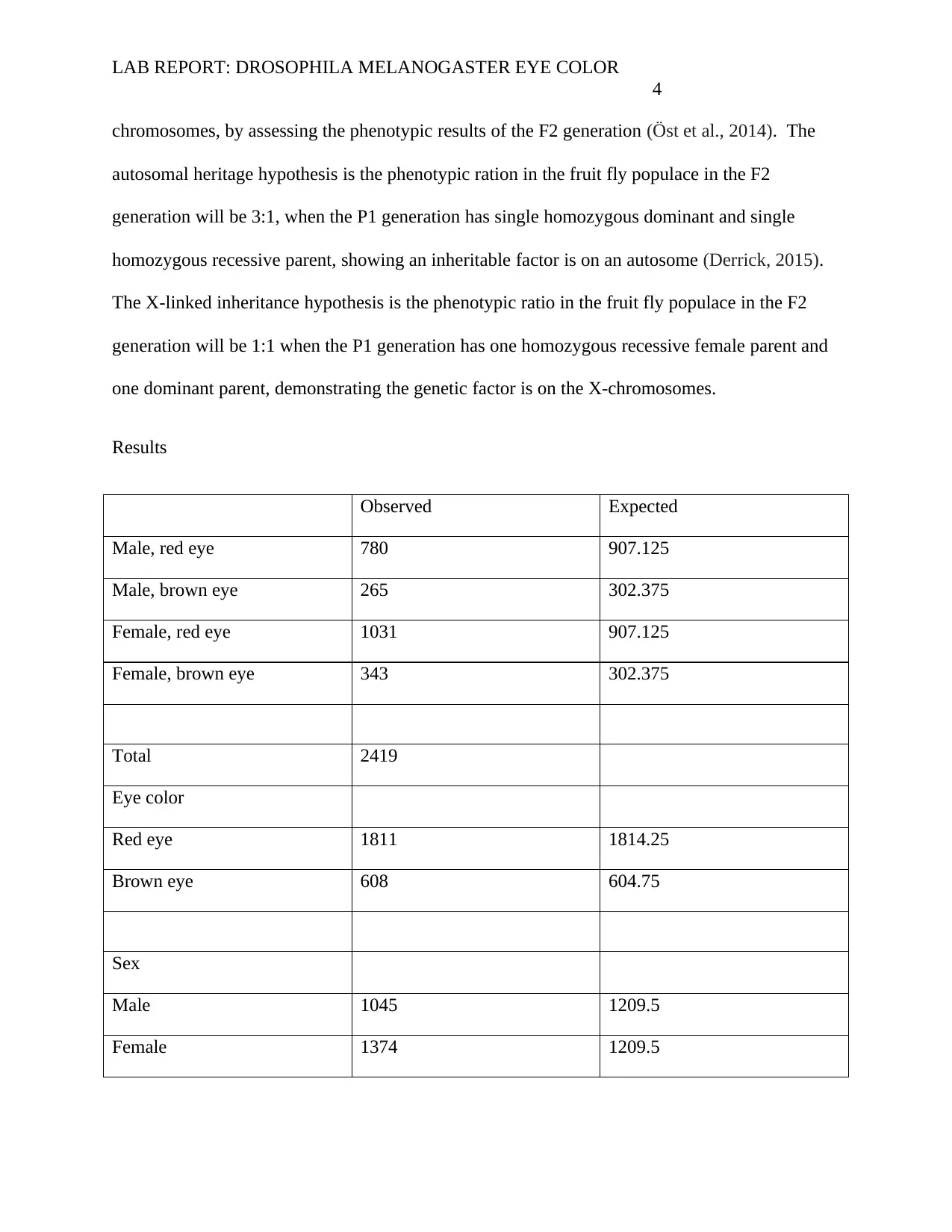
LAB REPORT: DROSOPHILA MELANOGASTER EYE COLOR
4
chromosomes, by assessing the phenotypic results of the F2 generation (Öst et al., 2014). The
autosomal heritage hypothesis is the phenotypic ration in the fruit fly populace in the F2
generation will be 3:1, when the P1 generation has single homozygous dominant and single
homozygous recessive parent, showing an inheritable factor is on an autosome (Derrick, 2015).
The X-linked inheritance hypothesis is the phenotypic ratio in the fruit fly populace in the F2
generation will be 1:1 when the P1 generation has one homozygous recessive female parent and
one dominant parent, demonstrating the genetic factor is on the X-chromosomes.
Results
Observed Expected
Male, red eye 780 907.125
Male, brown eye 265 302.375
Female, red eye 1031 907.125
Female, brown eye 343 302.375
Total 2419
Eye color
Red eye 1811 1814.25
Brown eye 608 604.75
Sex
Male 1045 1209.5
Female 1374 1209.5
4
chromosomes, by assessing the phenotypic results of the F2 generation (Öst et al., 2014). The
autosomal heritage hypothesis is the phenotypic ration in the fruit fly populace in the F2
generation will be 3:1, when the P1 generation has single homozygous dominant and single
homozygous recessive parent, showing an inheritable factor is on an autosome (Derrick, 2015).
The X-linked inheritance hypothesis is the phenotypic ratio in the fruit fly populace in the F2
generation will be 1:1 when the P1 generation has one homozygous recessive female parent and
one dominant parent, demonstrating the genetic factor is on the X-chromosomes.
Results
Observed Expected
Male, red eye 780 907.125
Male, brown eye 265 302.375
Female, red eye 1031 907.125
Female, brown eye 343 302.375
Total 2419
Eye color
Red eye 1811 1814.25
Brown eye 608 604.75
Sex
Male 1045 1209.5
Female 1374 1209.5
Paraphrase This Document
Need a fresh take? Get an instant paraphrase of this document with our AI Paraphraser
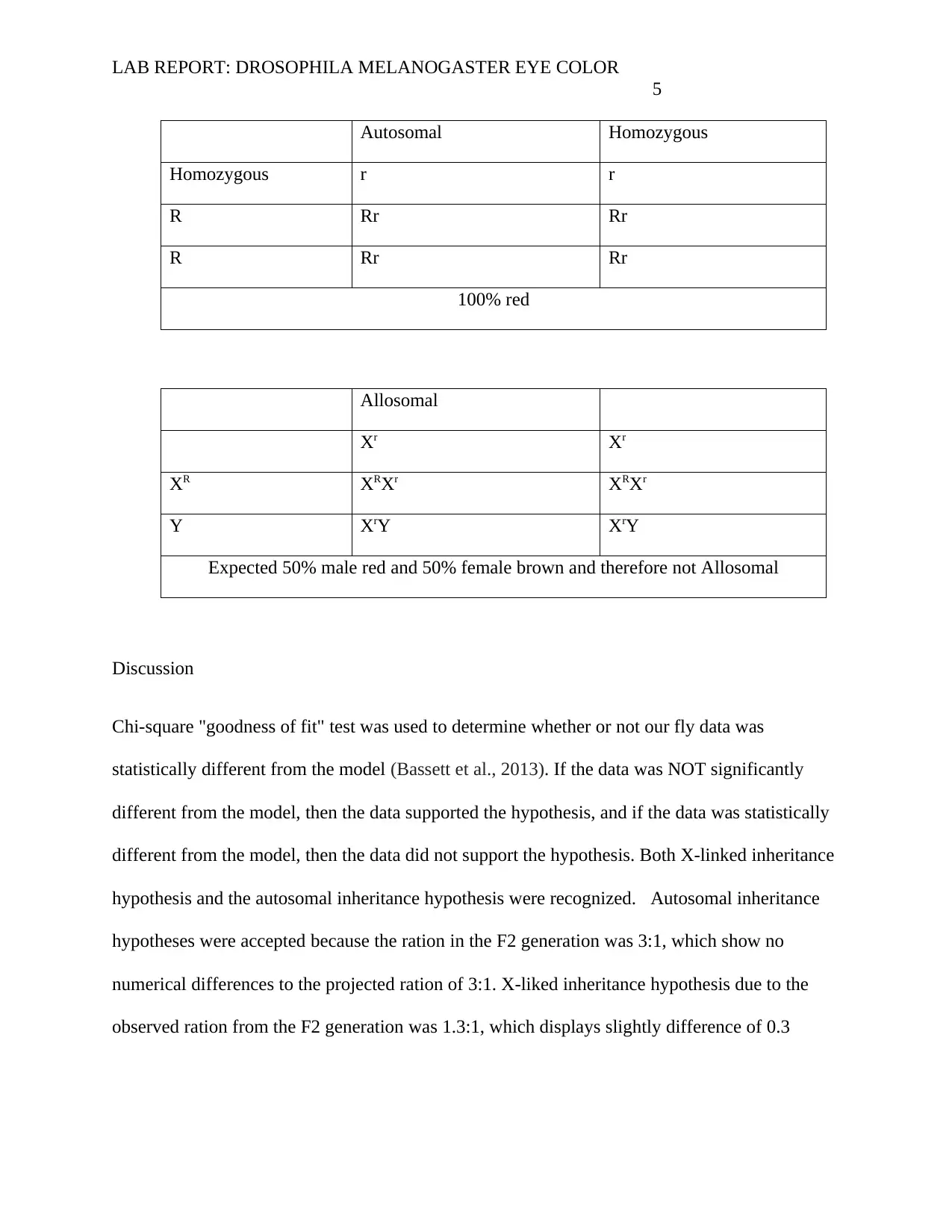
LAB REPORT: DROSOPHILA MELANOGASTER EYE COLOR
5
Autosomal Homozygous
Homozygous r r
R Rr Rr
R Rr Rr
100% red
Allosomal
Xr Xr
XR XRXr XRXr
Y XrY XrY
Expected 50% male red and 50% female brown and therefore not Allosomal
Discussion
Chi-square "goodness of fit" test was used to determine whether or not our fly data was
statistically different from the model (Bassett et al., 2013). If the data was NOT significantly
different from the model, then the data supported the hypothesis, and if the data was statistically
different from the model, then the data did not support the hypothesis. Both X-linked inheritance
hypothesis and the autosomal inheritance hypothesis were recognized. Autosomal inheritance
hypotheses were accepted because the ration in the F2 generation was 3:1, which show no
numerical differences to the projected ration of 3:1. X-liked inheritance hypothesis due to the
observed ration from the F2 generation was 1.3:1, which displays slightly difference of 0.3
5
Autosomal Homozygous
Homozygous r r
R Rr Rr
R Rr Rr
100% red
Allosomal
Xr Xr
XR XRXr XRXr
Y XrY XrY
Expected 50% male red and 50% female brown and therefore not Allosomal
Discussion
Chi-square "goodness of fit" test was used to determine whether or not our fly data was
statistically different from the model (Bassett et al., 2013). If the data was NOT significantly
different from the model, then the data supported the hypothesis, and if the data was statistically
different from the model, then the data did not support the hypothesis. Both X-linked inheritance
hypothesis and the autosomal inheritance hypothesis were recognized. Autosomal inheritance
hypotheses were accepted because the ration in the F2 generation was 3:1, which show no
numerical differences to the projected ration of 3:1. X-liked inheritance hypothesis due to the
observed ration from the F2 generation was 1.3:1, which displays slightly difference of 0.3
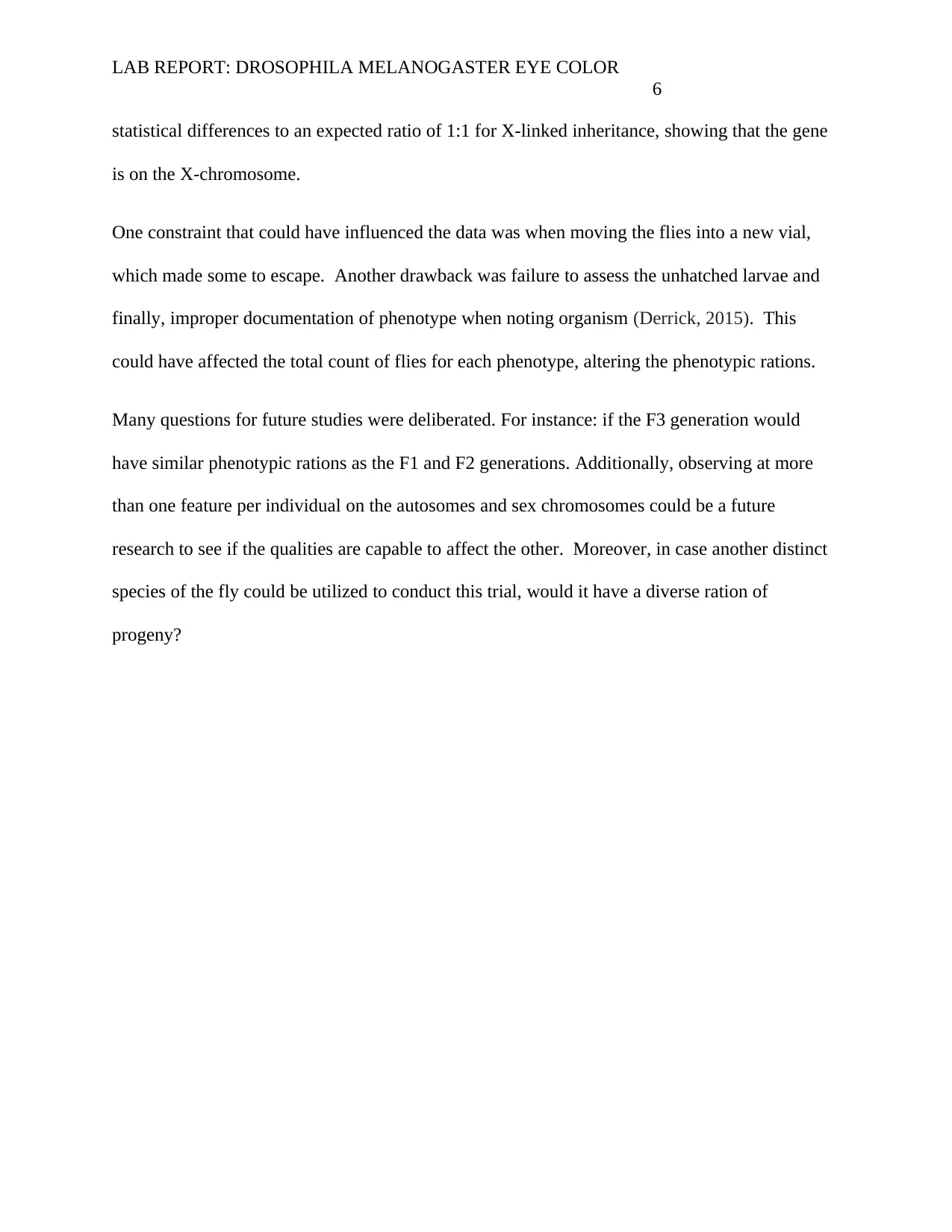
LAB REPORT: DROSOPHILA MELANOGASTER EYE COLOR
6
statistical differences to an expected ratio of 1:1 for X-linked inheritance, showing that the gene
is on the X-chromosome.
One constraint that could have influenced the data was when moving the flies into a new vial,
which made some to escape. Another drawback was failure to assess the unhatched larvae and
finally, improper documentation of phenotype when noting organism (Derrick, 2015). This
could have affected the total count of flies for each phenotype, altering the phenotypic rations.
Many questions for future studies were deliberated. For instance: if the F3 generation would
have similar phenotypic rations as the F1 and F2 generations. Additionally, observing at more
than one feature per individual on the autosomes and sex chromosomes could be a future
research to see if the qualities are capable to affect the other. Moreover, in case another distinct
species of the fly could be utilized to conduct this trial, would it have a diverse ration of
progeny?
6
statistical differences to an expected ratio of 1:1 for X-linked inheritance, showing that the gene
is on the X-chromosome.
One constraint that could have influenced the data was when moving the flies into a new vial,
which made some to escape. Another drawback was failure to assess the unhatched larvae and
finally, improper documentation of phenotype when noting organism (Derrick, 2015). This
could have affected the total count of flies for each phenotype, altering the phenotypic rations.
Many questions for future studies were deliberated. For instance: if the F3 generation would
have similar phenotypic rations as the F1 and F2 generations. Additionally, observing at more
than one feature per individual on the autosomes and sex chromosomes could be a future
research to see if the qualities are capable to affect the other. Moreover, in case another distinct
species of the fly could be utilized to conduct this trial, would it have a diverse ration of
progeny?
⊘ This is a preview!⊘
Do you want full access?
Subscribe today to unlock all pages.

Trusted by 1+ million students worldwide

LAB REPORT: DROSOPHILA MELANOGASTER EYE COLOR
7
References
Bassett, A. R., Tibbit, C., Ponting, C. P., & Liu, J. L. (2013). Highly efficient targeted
mutagenesis of Drosophila with the CRISPR/Cas9 system. Cell reports, 4(1), 220-228.
[Online]. Available at:
https://www.sciencedirect.com/science/article/pii/S2211124713003124
Derrick, G. E. (2015). The development of the eye and optic tract in Drosophila melanogaster
and its" eyeless" mutant. In Proceedings of the Oklahoma Academy of Science(Vol. 8, pp.
100-105). [Online]. Available at:
http://ojs.library.okstate.edu/osu/index.php/OAS/article/download/2561/2259
Hersh, B. M. (2016). More than meets the eye: A primer for “Timing of locomotor recovery
from anoxia modulated by the white gene in Drosophila melanogaster”. Genetics, 204(4),
1369-1375. [Online]. Available at: http://www.genetics.org/content/204/4/1369.abstract
Lindsley, D. L., & Zimm, G. G. (2012). The genome of Drosophila melanogaster. Academic
Press. [Online]. Available at: https://books.google.com/books?
hl=en&lr=&id=sklm5UmoGykC&oi=fnd&pg=PP1&dq=Drosophila+melanogaster+eye+
genotype+and+phenotype&ots=g5781hkCXV&sig=-
RtxN4YgCakFlucLRvmXrVBU5Xo
Okada, H., Ebhardt, H. A., Vonesch, S. C., Aebersold, R., & Hafen, E. (2016). Proteome-wide
association studies identify biochemical modules associated with a wing-size phenotype
in Drosophila melanogaster. Nature communications, 7, 12649. [Online]. Available at:
https://www.nature.com/articles/ncomms12649
7
References
Bassett, A. R., Tibbit, C., Ponting, C. P., & Liu, J. L. (2013). Highly efficient targeted
mutagenesis of Drosophila with the CRISPR/Cas9 system. Cell reports, 4(1), 220-228.
[Online]. Available at:
https://www.sciencedirect.com/science/article/pii/S2211124713003124
Derrick, G. E. (2015). The development of the eye and optic tract in Drosophila melanogaster
and its" eyeless" mutant. In Proceedings of the Oklahoma Academy of Science(Vol. 8, pp.
100-105). [Online]. Available at:
http://ojs.library.okstate.edu/osu/index.php/OAS/article/download/2561/2259
Hersh, B. M. (2016). More than meets the eye: A primer for “Timing of locomotor recovery
from anoxia modulated by the white gene in Drosophila melanogaster”. Genetics, 204(4),
1369-1375. [Online]. Available at: http://www.genetics.org/content/204/4/1369.abstract
Lindsley, D. L., & Zimm, G. G. (2012). The genome of Drosophila melanogaster. Academic
Press. [Online]. Available at: https://books.google.com/books?
hl=en&lr=&id=sklm5UmoGykC&oi=fnd&pg=PP1&dq=Drosophila+melanogaster+eye+
genotype+and+phenotype&ots=g5781hkCXV&sig=-
RtxN4YgCakFlucLRvmXrVBU5Xo
Okada, H., Ebhardt, H. A., Vonesch, S. C., Aebersold, R., & Hafen, E. (2016). Proteome-wide
association studies identify biochemical modules associated with a wing-size phenotype
in Drosophila melanogaster. Nature communications, 7, 12649. [Online]. Available at:
https://www.nature.com/articles/ncomms12649
Paraphrase This Document
Need a fresh take? Get an instant paraphrase of this document with our AI Paraphraser

LAB REPORT: DROSOPHILA MELANOGASTER EYE COLOR
8
Öst, A., Lempradl, A., Casas, E., Weigert, M., Tiko, T., Deniz, M., ... & Ruf, M. (2014). Paternal
diet defines offspring chromatin state and intergenerational obesity. Cell, 159(6), 1352-
1364. [Online]. Available at:
https://www.sciencedirect.com/science/article/pii/S0092867414014366
Tyler, D. M., Li, W., Zhuo, N., Pellock, B., & Baker, N. E. (2007). Genes affecting cell
competition in Drosophila. Genetics, 175(2), 643-657. [Online]. Available at:
http://www.genetics.org/content/175/2/643.full-text.pdf+html
Waddington, C. H. (2014). The strategy of the genes. Routledge. 1st ed. [Online]. Available at:
https://www.taylorfrancis.com/books/9781317657552
8
Öst, A., Lempradl, A., Casas, E., Weigert, M., Tiko, T., Deniz, M., ... & Ruf, M. (2014). Paternal
diet defines offspring chromatin state and intergenerational obesity. Cell, 159(6), 1352-
1364. [Online]. Available at:
https://www.sciencedirect.com/science/article/pii/S0092867414014366
Tyler, D. M., Li, W., Zhuo, N., Pellock, B., & Baker, N. E. (2007). Genes affecting cell
competition in Drosophila. Genetics, 175(2), 643-657. [Online]. Available at:
http://www.genetics.org/content/175/2/643.full-text.pdf+html
Waddington, C. H. (2014). The strategy of the genes. Routledge. 1st ed. [Online]. Available at:
https://www.taylorfrancis.com/books/9781317657552
1 out of 8
Related Documents
Your All-in-One AI-Powered Toolkit for Academic Success.
+13062052269
info@desklib.com
Available 24*7 on WhatsApp / Email
![[object Object]](/_next/static/media/star-bottom.7253800d.svg)
Unlock your academic potential
Copyright © 2020–2025 A2Z Services. All Rights Reserved. Developed and managed by ZUCOL.





